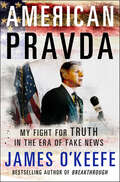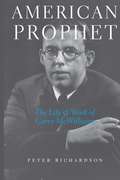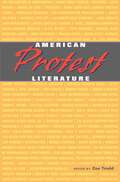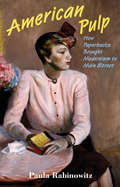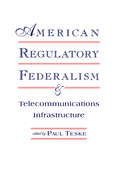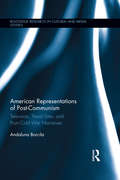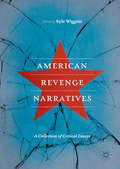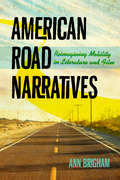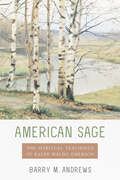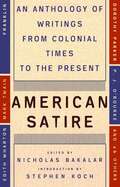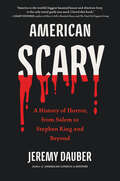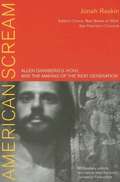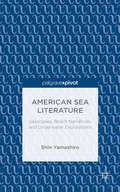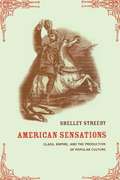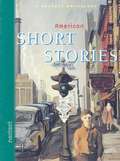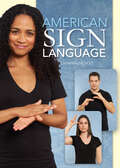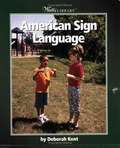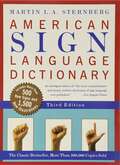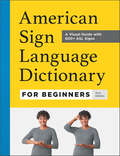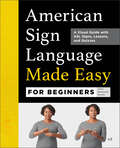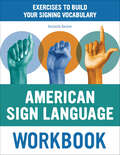- Table View
- List View
American Pravda: My Fight for Truth in the Era of Fake News
by James O'KeefeThe one real difference between the American press and the Soviet state newspaper Pravda was that the Russian people knew they were being lied to. To expose the lies our media tell us today, controversial journalist James O’Keefe created Project Veritas, an independent news organization whose reporters go where traditional journalists dare not. Their investigative work–equal parts James Bond, Mike Wallace, and Saul Alinsky—has had a consistent and powerful impact on its targets.In American Pravda, the reader is invited to go undercover with these intrepid journalists as they infiltrate political campaigns, unmask dishonest officials and expose voter fraud. A rollicking adventure story on one level, the book also serves as a treatise on modern media, arguing that establishment journalists have a vested interest in keeping the powerful comfortable and the people misinformed.The book not only contests the false narratives frequently put forth by corporate media, it documents the consequences of telling the truth in a world that does not necessarily want to hear it. O’Keefe’s enemies attack with lawsuits, smear campaigns, political prosecutions, and false charges in an effort to shut down Project Veritas. For O’Keefe, every one of these attacks is a sign of success.American Pravda puts the myths and misconceptions surrounding O’Keefe’s activities to rest and will make you rethink every word you hear and read in the so-called mainstream press.
American Prophet: The Life & Work of Carey McWilliams
by Peter RichardsonA long-overdue book on the brilliant life and career of one of our greatest public intellectuals, American Prophet will introduce Carey McWilliams to a new generation of readers. Peter Richardson's absorbing and elegantly paced book reveals a figure thoroughly engaged with the issues of his time. Deftly interweaving correspondence, diary notes, published writings, and McWilliams's own and others' observations on a colorful and influential cast of characters from Hollywood, New York, Washington, DC, and the American West, Richardson maps the evolution of McWilliams's personal and professional life. Among those making an appearance are H. L. Mencken (McWilliams's mentor and role model), Louis Adamic, John Fante, Robert Towne, Richard Nixon, Studs Terkel, J. Edgar Hoover, Arthur Schlesinger, Jr., and Joseph McCarthy. American Prophet illustrates the arc of McWilliams's life and career from his early literary journalism through his legal and political activism, his stint in state government, and his two decades as editor of the Nation. This book makes the case for McWilliams's place in the Olympian realm of our most influential and prescient political writers.
American Protest Literature (The John Harvard library #99)
by Howard Zinn“I like a little rebellion now and then”—so wrote Thomas Jefferson to Abigail Adams, enlisting in a tradition that throughout American history has led writers to rage and reason, prophesy and provoke. This is the first anthology to collect and examine an American literature that holds the nation to its highest ideals, castigating it when it falls short and pointing the way to a better collective future.American Protest Literature presents sources from eleven protest movements—political, social, and cultural—from the Revolution to abolition to gay rights to antiwar protest. Each section reprints documents from the original phase of the movement as well as evidence of its legacy in later times. Informative headnotes place the selections in historical context and draw connections with other writings within the anthology and beyond. Sources include a wide variety of genres—pamphlets, letters, speeches, sermons, legal documents, poems, short stories, photographs, posters—and a range of voices from prophetic to outraged to sorrowful, from U.S. Presidents to the disenfranchised. Together they provide an enlightening and inspiring survey of this most American form of literature.
American Pulp
by Paula Rabinowitz"There is real hope for a culture that makes it as easy to buy a book as it does a pack of cigarettes."--a civic leader quoted in a New American Library ad (1951)American Pulp tells the story of the midcentury golden age of pulp paperbacks and how they brought modernism to Main Street, democratized literature and ideas, spurred social mobility, and helped readers fashion new identities. Drawing on extensive original research, Paula Rabinowitz unearths the far-reaching political, social, and aesthetic impact of the pulps between the late 1930s and early 1960s.Published in vast numbers of titles, available everywhere, and sometimes selling in the millions, pulps were throwaway objects accessible to anyone with a quarter. Conventionally associated with romance, crime, and science fiction, the pulps in fact came in every genre and subject. American Pulp tells how these books ingeniously repackaged highbrow fiction and nonfiction for a mass audience, drawing in readers of every kind with promises of entertainment, enlightenment, and titillation. Focusing on important episodes in pulp history, Rabinowitz looks at the wide-ranging effects of free paperbacks distributed to World War II servicemen and women; how pulps prompted important censorship and First Amendment cases; how some gay women read pulp lesbian novels as how-to-dress manuals; the unlikely appearance in pulp science fiction of early representations of the Holocaust; how writers and artists appropriated pulp as a literary and visual style; and much more. Examining their often-lurid packaging as well as their content, American Pulp is richly illustrated with reproductions of dozens of pulp paperback covers, many in color.A fascinating cultural history, American Pulp will change the way we look at these ephemeral yet enduringly intriguing books.Some images inside the book are unavailable due to digital copyright restrictions.
American Realism and Naturalism
by Donald PizerDonald Pizer presents the major critical discussions of American realism and naturalism from the beginnings of the movement in the 1870s to the present. He includes the most often cited discussions ranging from William Dean Howells, Henry James, and Frank Norris in the late nineteenth century to those by V. L. Parrington, Malcolm Cowley, and Lionel Trilling in the early twentieth century. To provide the full context for the effort to interpret the nature and significance of realism and naturalism during the periods when the movements were live issues on the critical scene, however, he also includes many uncollected essays. His selections since World War II reflect the major recent tendencies in academic criticism of the movements. Through introductions to each of the three sections, Pizer provides background, delineating the underlying issues motivating attempts to attack, defend, or describe American realism and naturalism. In particular, Pizer attempts to reveal the close ties between criticism of the two movements and significant cultural concerns of the period in which the criticism appeared. Before each selection, Pizer provides a brief biographical note and establishes the cultural milieu in which the essay was originally published. He closes his anthology with a bibliography of twentieth-century academic criticism of American realism and naturalism.
American Regulatory Federalism and Telecommunications Infrastructure (LEA Telecommunications Series)
by Paul TeskeDuring this era of construction of the information superhighway, this volume presents a prudent analysis of the pros and cons of continuing state regulation of telecommunications. While interested parties either attack or defend state regulation, careful scholarly analysis is required to strike the appropriate balance of regulatory federalism. Focusing on regulation in the 1990s, it uses a positive political economy perspective to analyze enduring state-federal conflicts and to weigh the justifications and explanations for continuing state telecommunications regulation, or for changing its structure. It also considers normative concerns and makes recommendations about how to improve telecommunications policy. Seriously concerned with assessing the problems surrounding cost burdens for different categories of consumers, market entry for different firms, economic growth and the information infrastructure, global competitiveness, and control over information, this volume attempts to provide answers to the following specific questions: * How are states regulating telecommunications in the brave new world of global markets, fiber optics, and digital technology? * Do states vary significantly in their regulatory models? * How are the politics of state and federal regulation different? * Would a different federal-state relationship better serve national telecommunications goals in the future? To tackle these critical questions, the scholarly perspectives of economists, lawyers, political scientists, and telecommunications consultants and practitioners are employed.
American Renaissance Art and Expression: The Age of Emerson and Whitman
by F. O. MatthiessenSurvey of literary thought stressing the first half of the nineteenth century.
American Representations of Post-Communism: Television, Travel Sites, and Post-Cold War Narratives (Routledge Research in Cultural and Media Studies)
by Andaluna BorcilaWith the televised events of 1989, territories of Eastern and Central Europe that had been marked as impenetrable and inaccessible to the Western gaze exploded into visibility. As the narratives of the Cold War crumbled, new narratives emerged and new geographies were produced on and by American television. Using an understudied archive of American news broadcasts, and tracing their flashes and echoes through travel guides and narratives of return written by Eastern European-Americans, this book explores American ways of seeing and mapping communism’s disintegration and the narratives articulated around post-communist sites and subjects.
American Revenge Narratives: A Collection of Critical Essays
by Kyle WigginsAmerican Revenge Narratives critically examines the nation’s vengeful storytelling tradition. With essays on late twentieth and twenty-first century fiction, film, and television, it maps the coordinates of the revenge genre’s contemporary reinvention across American culture. By surveying American revenge narratives, this book measures how contemporary payback plots appraise the nation’s political, social, and economic inequities. The volume’s essays collectively make the case that retribution is a defining theme of post-war American culture and an artistic vehicle for critique. In another sense, this book presents a scholarly coming to terms with the nation’s love for vengeance. By investigating recent iterations of an ancient genre, contributors explore how the revenge narrative evolves and thrives within American literary and filmic imagination. Taken together, the book’s diverse chapters attempt to understand American culture’s seemingly inexhaustible production of vengeful tales.
American Revolution: Activity Book (Amplify Core Knowledge Language Arts, Grade 4 #Unit 7)
by Amplify EducationNIMAC-sourced textbook
American Revolution: Reader (Amplify Core Knowledge Language Arts, Grade 4 #Unit 7)
by Amplify EducationNIMAC-sourced textbook
American Road Narratives: Reimagining Mobility in Literature and Film (Cultural Frames, Framing Culture)
by Ann BrighamThe freedom to go anywhere and become anyone has profoundly shaped our national psyche. Transforming our sense of place and identity--whether in terms of social and economic status, or race and ethnicity, or gender and sexuality--American mobility is perhaps nowhere more vividly captured than in the image of the open road. From pioneer trails to the latest car commercial, the road looms large as a form of expansiveness and opportunity.Too often it is the celebratory idea of the road as a free-floating zone moving the traveler beyond the typical concerns of space and time that dominates the discussion. Rather than thinking of mobility as an escape from cultural tensions, however, Ann Brigham proposes that we understand mobility as a mode of engagement with them. She explores the genre of road narratives to show how mobility both thrives on and attempts to manage shifting conflicts about space and society in the United States.From the earliest transcontinental automobile narratives from the 1910s, through classics like Jack Kerouac's On the Road and the film Thelma & Louise, up to post-9/11 narratives, Brigham traces the ways in which mobility has been imagined, created, and interrogated over the past century and shows how mobility promises, and threatens, to incorporate the outsider and to blur boundaries. Bringing together textual and cultural analysis, theories of spatiality, and sociohistorical frameworks, this book offers an invigoratingly different view of mobility and a new understanding of the road narrative's importance in American culture. Cultural Frames, Framing Culture
American Sage: The Spiritual Teachings of Ralph Waldo Emerson
by Barry M. Andrews&“Succeeds in making Emerson&’s ideas and recommended spiritual practices accessible. . . . [For] those interested in nineteenth-century American spiritualism.&” —Publishers Weekly Even during his lifetime, Ralph Waldo Emerson was called the Sage of Concord, a fitting title for this leader of the American Transcendentalist movement. Everything that Emerson said and wrote directly addressed the conduct of life, and in his view, spiritual truth and understanding were the essence of religion. Unsurprisingly, he sought to rescue spirituality from decay, eschewing dry preaching and rote rituals. Unitarian minister Barry M. Andrews has spent years studying Emerson, finding wisdom and guidance in his teachings and practices, and witnessing how the spiritual lives of others are enriched when they grasp the many meanings in his work. In American Sage, Andrews explores Emerson's writings, including his journals and letters, and makes them accessible to today's spiritual seekers. Written in everyday language and based on scholarship grounded in historical detail, this enlightening book considers the nineteenth-century religious and intellectual crosscurrents that shaped Emerson's worldview to reveal how his spiritual teachings remain timeless and modern, universal and uniquely American. &“An ideal companion for readers working through Emerson's essays, a reading group on spirituality, and any number of classroom situations.&” —David M. Robinson, author of Emerson and the Conduct of Life: Pragmatism and Ethical Purpose in the Later Work &“In a style that is both scholarly and highly readable, Andrews offers an insightful account of Emerson's teachings. . . . demonstrating how his ideas are relevant to readers of today who are poised between faith and unbelief.&” —Phyllis Cole, author of Mary Moody Emerson and the Origins of Transcendentalism: A Family History
American Satire: An Anthology of Writings from Colonial Times to the Present
by Nicholas BakalarThis entertaining, informative collection covers the best of American satire—from Ben Franklin's cutting satiric attacks to Nathaniel Hawthorne's Celestial Railroad, Calvin Trillin's Old Marrieds, Mark Twain's American Abroad to P.J. O'Rourke's The Innocents Abroad—Updated, a late 20th-century take on Twain's classic piece. "Entertaining and satisfying...An excellent introduction."—Amazon.com.
American Scary: A History of Horror, from Salem to Stephen King and Beyond
by Jeremy Dauber"America is the world's biggest haunted house and American Scary is the only travel guide you need. I loved this book." —Grady Hendrix, New York Times bestselling author of How to Sell a Haunted House and The Final Girl Support GroupFrom the acclaimed author of American Comics comes a sweeping and entertaining narrative that details the rise and enduring grip of horror in American literature, and, ultimately, culture—from the taut, terrifying stories of Edgar Allan Poe to the grisly, lingering films of Jordan Peele America is held captive by horror stories. They flicker on the screen of a darkened movie theater and are shared around the campfire. They blare out in tabloid true-crime headlines, and in the worried voices of local news anchors. They are consumed, virally, on the phones in our pockets. Like the victims in any slasher movie worth its salt, we can&’t escape the thrall of scary stories. In American Scary, noted cultural historian and Columbia professor Jeremy Dauber takes the reader to the startling origins of horror in the United States. Dauber draws a captivating through line that ties historical influences ranging from the Salem witch trials and enslaved-person narratives directly to the body of work we more closely associate with horror today: the weird tales of H. P. Lovecraft, the lingering fiction of Shirley Jackson, the disquieting films of Alfred Hitchcock, the up-all-night stories of Stephen King, and the gripping critiques of Jordan Peele. With the dexterous weave of insight and style that have made him one of America&’s leading historians of popular culture, Dauber makes the haunting case that horror reveals the true depths of the American mind.
American Scream: Allen Ginsberg's Howl and the Making of the Beat Generation
by Jonah RaskinBiography of Allen Ginsberg, best known for his poem Howl, the emblem of the Beat Generation.
American Sea Literature: Seascapes, Beach Narratives, and Underwater Explorations
by Shin YamashiroImplementing a never-before-seen approach to sea literature, American Sea Literature: Seascapes, Beach Narratives, and Underwater Explorations explores the role of American maritime activities and their cultural representations in literature. Differentiating between the 'terrestrial' and 'oceanic' as concepts, Shin Yamashiro divides sea literature into three categories: literature on the sea, by the sea, and beneath the sea. Discussing both canonical works and new books on scuba diving, deep-sea explorations, and surfing, this fascinating study recognizes sea literature's unique influence on American history.
American Sensations: Class, Empire, and the Production of Popular Culture
by Shelley StreebyBy focusing on sensationalist literature of the period, Streeby explores issues of race, class, popular culture, and notions of empire in America around the U.S.-Mexican war.
American Short Stories
by Mcdougal LittellThe American short stories presented in the book are grouped under the following sections : Romanticism and Realism,The Birth of the Modern,Building a Tradition,New Voices and Identities.
American Sign Language
by Catherine NicholsIt's the third most used language in the United States-and yet it's "spoken" without even opening your mouth! It's estimated that as many as two million Americans speak American Sign Language, a method of communication that's both fun and useful, even if you or your friends and family are not hearing impaired.American Sign Language uses simple-to-follow photographs to teach you the alphabet, numbers, and simple words and phrases. Divided into categories such as Animals and People and Pronouns, the book and accompanying flashcards show you how to use your hands to communicate. Once you've learned the alphabet, you'll build on that knowledge to learn the words for "friend" and "family." And when you how the words for "chicken" and "cat" evoke a chicken opening and closing its beak and a cat stroking its whiskers, you'll truly understand how intuitive and enjoyable learning American Sign Language can be.Learning a new language is always a rewarding endeavor-and with American Sign Language, it's easier than ever!
American Sign Language
by Deborah KentThis book gives young readers a brief overview of American Sign Language (ASL). The book focuses on the history of ASL and the controversies which have surrounded it since its inception.
American Sign Language Dictionary
by Martin L. SternbergDeaf since the age of seven, Martin L. A. Sternberg, Ed.D., spent most of his career working with deaf people. Inspired by his sign language teacher at Gallaudet University in Washington, DC, he devised this vital reference to help anyone learn to speak with their hands. <p><p>A must for parents, instructors, and students, American Sign Language Dictionary includes everything you need to know to communicate clearly using ASL. This illustrated abridgment of the most authoritative reference book on sign language features more than 5,000 signs and 8,000 illustrations, as well as clear, detailed instructions to help you master each sign.
American Sign Language Dictionary for Beginners: A Visual Guide with 800+ ASL Signs
by Tara AdamsA user-friendly dictionary with 800+ ASL signs Whatever your reason for learning the richly expressive language of American Sign Language (ASL), this book will guide you through the initial stages of your signing journey. It's filled with everything you need to master more than 800 essential vocabulary words, including detailed directions that make it simple to develop your ASL skills.What sets this dictionary apart from other sign language books for beginners:No experience required—Find comprehensive, clearly written guidance that makes sense of American Sign Language for beginners, with helpful explanations of more difficult concepts, plus plenty of tips for success.Instructional photographs—See ASL in action with full-color photographs that illustrate how to sign each vocabulary word.Easy-to-find signs—Study each sign in alphabetical order or search by category with a handy index that organizes signs by activities, animals, emotions, places, events, and more.Build up your ASL vocabulary with the American Sign Language Dictionary for Beginners.
American Sign Language Made Easy for Beginners: A Visual Guide with ASL Signs, Lessons, and Quizzes
by Travis Belmontes-MerrellLearn American Sign Language the easy way! Become a lifelong learner of American Sign Language (ASL) with this guide for true beginners. It breaks down ASL fundamentals and gives you step-by-step instructions for signing more than 400 vocabulary words, organized by practical topics like greetings, hobbies, times, places, and more.The building blocks of ASL—Lay the foundation for ASL learning as you explore the five parameters of signing: handshape, location, movement, palm orientation, and non-manual markers.Clear guidance for novices—Learn how to sign each vocabulary word with the help of detailed written directions and large, full-color photos, so you know you're doing it right even if it's your first sign ever.Lessons and quizzes—Put your new skills to the test with themed lessons designed for real-world conversations, and brief quizzes at the end of each section.Make learning ASL fun and easy with this top choice in American Sign Language books for beginners.
American Sign Language Workbook: Exercises to Build Your Signing Vocabulary
by Rochelle BarlowThe simple way to start learning American Sign LanguageThis foundational workbook makes it easy to get started with American Sign Language. Focusing on practical vocabulary and basic grammar, this workbook is ideal for anyone trying to understand and speak ASL right away. Across 30+ lessons, you'll be introduced to the essentials, including everyday vocabulary, introductory phrases, and conversational basics.Everyday communication—Lessons are centered around real-world situations, including greetings, emotions, family, work, travel, and health.Easy-to-understand lessons—High-quality photos support the straightforward sign descriptions and ensure accurate instruction.Practice makes perfect—Test your knowledge with a variety of exercises, including matching, fill-in-the-blanks, and more.Lay the foundation for strong signing skills with the simple exercises in this sign language workbook.
